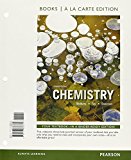
Chemistry, Books a la Carte Edition and Modified Mastering Chemistry with Pearson eText & ValuePack Access Card (7th Edition)
7th Edition
ISBN: 9780134172514
Author: John E. McMurry
Publisher: PEARSON
expand_more
expand_more
format_list_bulleted
Question
Chapter 19, Problem 19.2A
Interpretation Introduction
Interpretation:
Identification of isotopes and type of decay process which occurs in nuclear reaction.
Concept introduction. Element with
The mass number is defined as the sum of atomic number and neutrons.
Expert Solution & Answer
Want to see the full answer?
Check out a sample textbook solution
Students have asked these similar questions
Please explain how to calculate the pH.
I'm having trouble with converting lewis diagrams into VSEPR diagrams. I currently have this example of C2BrCl3 which I want to turn into a lewis structure, but I'm not sure what steps I need to do in order to do so. I have the table written down, however, there's two central atoms so what would I do? There seems to be 4 electron domains on the carbon atom and no lone pairs so it would seem like this shape would be tetrahedral. Here's what I have now. Thanks!
We discussed the solid phase resin using in peptide synthesis. Provide a mechanism, for its formation. DRAW THE MECHANISM.
Chapter 19 Solutions
Chemistry, Books a la Carte Edition and Modified Mastering Chemistry with Pearson eText & ValuePack Access Card (7th Edition)
Ch. 19 - Prob. 19.1PCh. 19 - Prob. 19.2ACh. 19 - Prob. 19.3PCh. 19 - Prob. 19.4PCh. 19 - Prob. 19.5PCh. 19 - Prob. 19.6ACh. 19 - Prob. 19.7PCh. 19 - Prob. 19.8ACh. 19 - Prob. 19.9PCh. 19 - Prob. 19.10A
Ch. 19 - Prob. 19.11PCh. 19 - Prob. 19.12ACh. 19 - Prob. 19.13PCh. 19 - Prob. 19.14ACh. 19 - Prob. 19.15PCh. 19 - Prob. 19.16ACh. 19 - Prob. 19.17PCh. 19 - Prob. 19.18PCh. 19 - Prob. 19.19ACh. 19 - Prob. 19.20PCh. 19 - Prob. 19.21ACh. 19 - Prob. 19.22PCh. 19 - Prob. 19.23PCh. 19 - Prob. 19.24PCh. 19 - Prob. 19.25PCh. 19 - Prob. 19.26PCh. 19 - Prob. 19.27CPCh. 19 - Prob. 19.28SPCh. 19 - Prob. 19.29SPCh. 19 - Prob. 19.30SPCh. 19 - Prob. 19.31SPCh. 19 - Prob. 19.32SPCh. 19 - Prob. 19.33SPCh. 19 - Prob. 19.34SPCh. 19 - Prob. 19.35SPCh. 19 - Prob. 19.36SPCh. 19 - Prob. 19.37SPCh. 19 - Prob. 19.38SPCh. 19 - Prob. 19.39SPCh. 19 - Prob. 19.40SPCh. 19 - Prob. 19.41SPCh. 19 - Prob. 19.42SPCh. 19 - Prob. 19.43SPCh. 19 - Prob. 19.44SPCh. 19 - Prob. 19.45SPCh. 19 - Prob. 19.46SPCh. 19 - Prob. 19.47SPCh. 19 - Prob. 19.48SPCh. 19 - Prob. 19.49SPCh. 19 - Prob. 19.50SPCh. 19 - Prob. 19.51SPCh. 19 - Prob. 19.52SPCh. 19 - Prob. 19.53SPCh. 19 - Prob. 19.54SPCh. 19 - Prob. 19.55SPCh. 19 - Prob. 19.56SPCh. 19 - Prob. 19.57SPCh. 19 - Prob. 19.58SPCh. 19 - Prob. 19.59SPCh. 19 - Prob. 19.60SPCh. 19 - Prob. 19.61SPCh. 19 - Prob. 19.62SPCh. 19 - Prob. 19.63SPCh. 19 - Prob. 19.64SPCh. 19 - Prob. 19.65SPCh. 19 - Prob. 19.66SPCh. 19 - Prob. 19.67SPCh. 19 - Prob. 19.68SPCh. 19 - Prob. 19.69SPCh. 19 - Prob. 19.70SPCh. 19 - Prob. 19.71SPCh. 19 - Prob. 19.72SPCh. 19 - Prob. 19.73SPCh. 19 - Prob. 19.74SPCh. 19 - Prob. 19.75SPCh. 19 - Prob. 19.76SPCh. 19 - Prob. 19.77SPCh. 19 - Prob. 19.78SPCh. 19 - Prob. 19.79SPCh. 19 - Prob. 19.80SPCh. 19 - Prob. 19.81SPCh. 19 - Prob. 19.82SPCh. 19 - Prob. 19.83SPCh. 19 - Prob. 19.84SPCh. 19 - Prob. 19.85SPCh. 19 - Prob. 19.86SPCh. 19 - Prob. 19.87SPCh. 19 - Prob. 19.88SPCh. 19 - Prob. 19.89SPCh. 19 - Prob. 19.90SPCh. 19 - Prob. 19.91SPCh. 19 - Prob. 19.92SPCh. 19 - Prob. 19.93SPCh. 19 - Prob. 19.94SPCh. 19 - Prob. 19.95SPCh. 19 - Prob. 19.96CPCh. 19 - Prob. 19.97CPCh. 19 - Prob. 19.98CPCh. 19 - Prob. 19.99CPCh. 19 - Prob. 19.100CPCh. 19 - Prob. 19.101CPCh. 19 - Prob. 19.102CPCh. 19 - Prob. 19.103CPCh. 19 - Prob. 19.104CPCh. 19 - Prob. 19.105CPCh. 19 - Prob. 19.106CPCh. 19 - Prob. 19.107CPCh. 19 - Prob. 19.108CPCh. 19 - Prob. 19.109CPCh. 19 - Prob. 19.110CPCh. 19 - Prob. 19.111CPCh. 19 - Prob. 19.112CPCh. 19 - Prob. 19.113MPCh. 19 - Prob. 19.114MPCh. 19 - Prob. 19.115MP
Knowledge Booster
Similar questions
- (a) 21.8 Name the following compounds. & (b) Br (e) O₂N. (h) H (c) Br (d) NH2 ☑N Br H ہیں Ph (g) OMe бл .0-0.e 21.9 Draw a structural formula for each compound. (a) 2,3-Dinitrotoluene (c) Diphenylmethanol (e) p-Nitroaniline (b) 3-Propylanisole (d) m-Propylphenol (f) Pentabromobenzenearrow_forwardIs this the major product of this reaction?arrow_forwardPlease helparrow_forward
arrow_back_ios
SEE MORE QUESTIONS
arrow_forward_ios
Recommended textbooks for you
 ChemistryChemistryISBN:9781305957404Author:Steven S. Zumdahl, Susan A. Zumdahl, Donald J. DeCostePublisher:Cengage Learning
ChemistryChemistryISBN:9781305957404Author:Steven S. Zumdahl, Susan A. Zumdahl, Donald J. DeCostePublisher:Cengage Learning ChemistryChemistryISBN:9781259911156Author:Raymond Chang Dr., Jason Overby ProfessorPublisher:McGraw-Hill Education
ChemistryChemistryISBN:9781259911156Author:Raymond Chang Dr., Jason Overby ProfessorPublisher:McGraw-Hill Education Principles of Instrumental AnalysisChemistryISBN:9781305577213Author:Douglas A. Skoog, F. James Holler, Stanley R. CrouchPublisher:Cengage Learning
Principles of Instrumental AnalysisChemistryISBN:9781305577213Author:Douglas A. Skoog, F. James Holler, Stanley R. CrouchPublisher:Cengage Learning Organic ChemistryChemistryISBN:9780078021558Author:Janice Gorzynski Smith Dr.Publisher:McGraw-Hill Education
Organic ChemistryChemistryISBN:9780078021558Author:Janice Gorzynski Smith Dr.Publisher:McGraw-Hill Education Chemistry: Principles and ReactionsChemistryISBN:9781305079373Author:William L. Masterton, Cecile N. HurleyPublisher:Cengage Learning
Chemistry: Principles and ReactionsChemistryISBN:9781305079373Author:William L. Masterton, Cecile N. HurleyPublisher:Cengage Learning Elementary Principles of Chemical Processes, Bind...ChemistryISBN:9781118431221Author:Richard M. Felder, Ronald W. Rousseau, Lisa G. BullardPublisher:WILEY
Elementary Principles of Chemical Processes, Bind...ChemistryISBN:9781118431221Author:Richard M. Felder, Ronald W. Rousseau, Lisa G. BullardPublisher:WILEY

Chemistry
Chemistry
ISBN:9781305957404
Author:Steven S. Zumdahl, Susan A. Zumdahl, Donald J. DeCoste
Publisher:Cengage Learning

Chemistry
Chemistry
ISBN:9781259911156
Author:Raymond Chang Dr., Jason Overby Professor
Publisher:McGraw-Hill Education

Principles of Instrumental Analysis
Chemistry
ISBN:9781305577213
Author:Douglas A. Skoog, F. James Holler, Stanley R. Crouch
Publisher:Cengage Learning

Organic Chemistry
Chemistry
ISBN:9780078021558
Author:Janice Gorzynski Smith Dr.
Publisher:McGraw-Hill Education

Chemistry: Principles and Reactions
Chemistry
ISBN:9781305079373
Author:William L. Masterton, Cecile N. Hurley
Publisher:Cengage Learning

Elementary Principles of Chemical Processes, Bind...
Chemistry
ISBN:9781118431221
Author:Richard M. Felder, Ronald W. Rousseau, Lisa G. Bullard
Publisher:WILEY